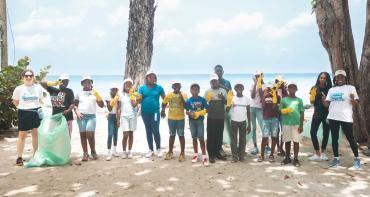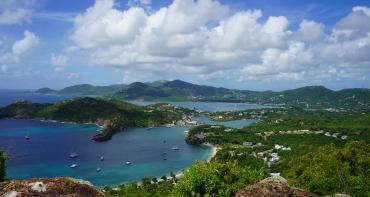The Commonwealth Blue Charter is highlighting case studies from the Commonwealth and beyond, as part of a series to spotlight best practice successes and experiences.

Share your own case study with us
“The process of assigning management categories to our national parks will help facilitate the planning of protected areas and protected area systems managed by BNT and other agencies, improve information management about protected areas and assist to regulate activities within protected areas.”
Eric Carey, Executive Director, Bahamas National Trust
Summary
At its first meeting, the Commonwealth Blue Charter Marine Protected Area (MPA) Action Group identified training on the International Union for Conservation of Nature (IUCN) protected area management categories as one of its capacity development needs. Each protected area should be assigned to one of these categories, and governments should provide information on categories when submitting data on protected areas to the World Database of Protected Areas. IUCN has produced detailed guidance on the categories but there are few documented examples of the assignment process.
Participants at the BIOPAMA-facilitated workshops
Credit: Lynn Gape, BNT
As part of the process to improve the management and expansion of The Bahamas MPA network, the Bahamas National Trust (BNT), with the Department of Marine Resources (DMR) and the Clifton Heritage Authority, undertook a process to assign IUCN protected area management categories to all sites under its purview, through a series of workshops in 2014.
Recommendations for categories for all designated protected areas, including MPAs, were made. This case study explains the purpose of the categories and the assignment process used in The Bahamas. Although the recommendations are still awaiting adoption and formalisation, this initiative provides useful lessons learnt and demonstrates the challenges involved.
The issue
The International Union for Conservation of Nature (IUCN) protected area management categories were designed with the aim of providing a tool to help with planning protected area systems; to encourage the development of protected area systems that include a range of conservation objectives tailored to national and local circumstances; to help global and regional data centres collect and report on conservation efforts; and to facilitate comparisons between countries.
The category assigned to a protected area must reflect the primary management objective(s) of the site. A category gives direction to site management and helps ensure that a protected area is designed and managed to meet its intended purpose. For example, if a development such as a tourism operation is proposed for a protected area, its category needs to be considered in case the development will prevent achievement of the protected area objectives. Since each protected area has its own goals and objectives, each site is likely to have a different management strategy, and the category helps ensure appropriate measures are implemented. Without categorisation, management may drift away from the original aim of the site. All the categories are important and a successful protected area network is likely to include sites of different categories.

Protected areas of The Bahamas (as of 2015) Credit: Lindy Knowles, BNT
Assigning categories can be difficult if there are multiple objectives and values for a site, as is often the case, or if the objectives are evolving and complex. IUCN provides guidance on assigning categories for all types of protected areas (Dudley, 2008), as well as specific guidance for Marine Protected Areas (MPAs) (Day, 2019), since the marine environment has certain unique characteristics. Both of these documents should be used for MPAs (given that the general guidance explains the key principles underlying the categories).
As part of the national effort to meet its commitments under the Caribbean Challenge Initiative (CCI), the Bahamas National Trust (BNT) decided to assign categories to its protected areas. The CCI was launched in 20082 to promote the protection and management of the marine and coastal environment with a goal of effective management of at least 20 per cent of a country’s nearshore and marine environment by 2020. The Bahamas was one of the first governments to participate, signing the Declaration in 2013. The 2012 Master Plan for the Bahamas National Protected Areas System (BNPAS) (Moultrie, 2012) had laid out a process to achieve this, and a series of research programmes and gap analyses were undertaken subsequently.
The Bahamas MPA network, currently covering just over 10 per cent of its territorial waters, has sites ranging from highly protected fishery replenishment areas to marine managed areas with multiple zones that allow varying levels of human interaction and extraction. Four MPAs are marine reserves and are managed by the Department of Marine Resources (DMR); a number are managed by the BNT; and those declared in 2015 have yet to be assigned a management agency. A three-year project, Bahamas Protected: Realising the 2020 Goal to Effectively Manage and Expand Bahamian Marine Protected Areas (Knowles et al., 2017), produced recommendations for 43 new and/or expanded MPAs to meet the 20 per cent area target; the BNT and its partners have submitted these (Anderson et al., 2018) to The Bahamian government and they are currently in the pipeline for approval.
As a component of the overall process, it was decided to assign the IUCN categories to ensure that the protected area system was aligned with international standards. It was also felt that formalised management categories would help address the increasing trend, in the Caribbean, towards de-gazetting protected areas, a consequence of rapid economic development.

The response
The IUCN guidance was used in designing the categorisation process. Workshops took participants through a sequence of exercises aimed at both ensuring a good understanding of the objectives of each site and building skills in decision-making using the categories.
Participants came from all the organisations involved in supporting, establishing and managing protected areas: BNT, DMR, the Department of Forestry, The Nature Conservancy Bahamas (TNC), The Bahamas Environment Science and Technology Commission, the Antiquities, Monuments and Museums Corporation and Clifton Heritage National Park.
A three-stage process was used, that took place over a nine-month period:
- Workshop 1: Issues identified; management categories and their role as an adaptive tool discussed; context of protected areas reviewed;
- Workshop 2: Issues and context identified in Workshop 1 organised into a conceptual framework;
- Workshop 3: Decisions made on potential categories; future activities identified in terms of requirements for new competencies, capacity and legal processes; process for completion
The last workshop doubled as a knowledge-sharing exercise and had participants from six other Caribbean islands – five Commonwealth countries (Grenada, Jamaica, Saint Lucia, St Vincent and the Grenadines, and Trinidad and Tobago) and one other (Dominican Republic).
Partnerships and support
The BNPAS categorisation workshops were undertaken in 2014 and were facilitated and sponsored by the Biodiversity and Protected Areas Management (BIOPAMA) programme, which is an initiative of the Organization of Africa, Caribbean and Pacific States, funded by the European Union under the 10th European Development Fund. IUCN and the European Commission Joint Research Centre implemented the process. Funding totalled about €48,000 and covered IUCN staff time, costs of the workshops, travel, accommodation and per diems.
Results, accomplishments and outcomes
At the final categorisation workshop, an agreement was reached on proposed categories for all designated protected areas (BNT, 2014), as shown in Annex 1 and summarised below:
In 2019, the BNT Council, which is a member of IUCN and responsible for this part of the process, approved the recommendations for the proposed categories, which are currently awaiting formalisation and implementation, at which stage the categories will be reported to the World Database on Protected Areas. Although the workshop developed a process for the classification of new protected areas, categories were not proposed for the MPAs designated in 2015; these sites have not yet been assigned to a management agency and it is recognised that category assignment is best undertaken in the course of preparing the management plans.
Challenges
COVID-19: The greatest current environmental, as well as economic and social, challenge for The Bahamas, as for most countries, is recovery from the COVID-19 pandemic. All countries and MPAs around the world have suffered a massive negative impact. With the cessation of tourism, many sources of income have dried up. MPA managers have had to focus on ensuring the safety and security of their staff. Reduced visitor numbers and disrupted supply chains for fishery products have significantly affected the livelihoods of local communities that may normally both depend on and help manage MPAs. MPA management is focusing down on core operations to maintain basic functioning. However, there is consensus that effectively managed MPAs will be more resilient and that a sustainable managed ocean, encompassing MPA networks of adequate size, will be an essential component of recovery. This pandemic, combined with the devastation to the northern Bahama islands by Hurricane Dorian in 2019, has left the country in a position where unfortunately environmental considerations are a lower priority than the environment.
The workshop participants found that some concepts behind the categorisation process were complex, and that, despite the IUCN guidance, definitions and terms were not necessarily easily understood. The technical advice and training provided by BIOPAMA was therefore invaluable. Training was needed for managers, wardens/ rangers, fisheries superintendents and others involved in the assignment process and tasked with subsequently interpreting the categories for other stakeholders.
The stakeholder engagement and workshop process needs careful design and facilitation to ensure that developers, investors and others with a vested interest do not influence the assignment process and reduce the level of ambition at a site for biodiversity protection.
As IUCN categories are assigned according to the objectives of a protected area; they do not necessarily reflect the name of the site or level of protection. This is clearly demonstrated by this example for The Bahamas, where most MPAs are called either national parks (used in the IUCN guidance for Category II sites) or marine reserves (Category I sites in the IUCN Guidance). The BNT plans to retain the current branding of national parks and on-going marketing approaches, thus clear explanations of Categories I and II sites will be needed. This issue of terminology will also need to be addressed as the proposed new MPAs are designated.
The other Commonwealth countries that participated in the final workshop have also had difficulties assigning categories and have found the process challenging. Categories have been assigned to all the sites in the Saint Lucia national protected area systems plan, but legislation to formalise this has not been implemented, and the other countries have not yet completed the process.
Key lessons learnt
The Bahamas process has validated much of the guidance provided for assigning the IUCN protected area management categories in terms of:
- The need to involve key stakeholders, and base the assessment on best available natural and social The three workshops were designed to ensure enough time for assimilation of information and also to facilitate the research and analysis required.
- The need to carefully assess the MPA objectives before assigning a IUCN category; this has additional value in that it can help with development or revision of a management plan and identification of appropriate management measures for a site.
As is recognised widely, the management categories are primarily a tool for protected area management agencies and the international conservation community, to help focus on objectives and to develop well-balanced frameworks for MPA systems. They do not lend themselves very well to use in external communications – a problem identified in many countries – except perhaps where they could help explain regulations and management interventions for a particular site.
Given this challenge, workshop participants discussed the possibility of creating new categories specifically for The Bahamas. In fact, this issue had been addressed, and resolved, previously. In the 1980s, when the protected area system was being expanded in The Bahamas, three broad categories were adopted: national park, protected area and national reserve. Over time, these names started to determine which agency managed a site, rather than the objectives of the site. A widely understood national “branding” for protected areas thus became established, as happens in many countries. However, the value of adopting the IUCN categories was also understood, since it provides a mechanism to align protected areas with international standards. It was nevertheless considered important to retain the existing naming system and so the management category, once agreed, is placed in brackets after the protected area name. Thus, for example, “national parks” in The Bahamas are those sites managed by the BNT but they have a variety of objectives that are reflected in their categories that help determine management.
Lead contacts
Eric Carey, Executive Director, Bahamas National Trust | E-Mail
Lakeshia Anderson-Rolle, Director of Parks, Bahamas National Trust. | E-Mail

Endnotes
- https://www.biopama.org/news/bahamas-moves-to-assign- protected-areas-management-categories52
- https://www.caribbeanchallengeinitiative.org/about
References
Anderson, L., Dahlgren, C., Knowles, L., Jupp, L. et al. (2018) “Bahamas Protected: 20 by 20 White Paper: Marine Protection Plan for Expanding The Bahamas Marine Protected Area Network”. Proposal Prepared for the Office of the Prime Minister, Ministry of Environment and Housing and the Ministry of Agriculture and Marine Resources
BNT (2014) “2014 Protected Areas Management Categories Analysis for the Bahamas January– September”. Final Report.
Day, J., Dudley, N., Hockings, M., Holmes, G. et al. (eds) (2019) Guidelines for Applying the IUCN Protected Area Management Categories to Marine Protected Areas. 2nd Edition. Gland: IUCN.
Dudley, N. (eds) (2008) Guidelines for Applying Protected Area Management Categories. Gland: IUCN. Updated as Stolton, S., Shadie, P. and Dudley, N. (2013) IUCN WCPA Best Practice Guidance on Recognising Protected Areas and Assigning Management Categories and Governance Types. Best Practice Protected Area Guidelines Series No. 21. Gland: IUCN.
Moultrie, S. (2012) “Master Plan for The Bahamas National Protected Area System”. Nassau: The Nature Conservancy, Northern Caribbean Office.
Knowles, J.E., Green, A.L., Dahlgren, C., Arnett, F. and Knowles, L. (2017) “Expanding The Bahamas Marine Protected Area Network to Protect 20% of the Marine and Coastal Environment by 2020”. A Gap Analysis.
Download this case study (PDF)
View all Case Studies
Media contact
- Josephine Latu-Sanft Senior Communications Officer, Communications Division, Commonwealth Secretariat
- +44 20 7747 6476 | E-mail



